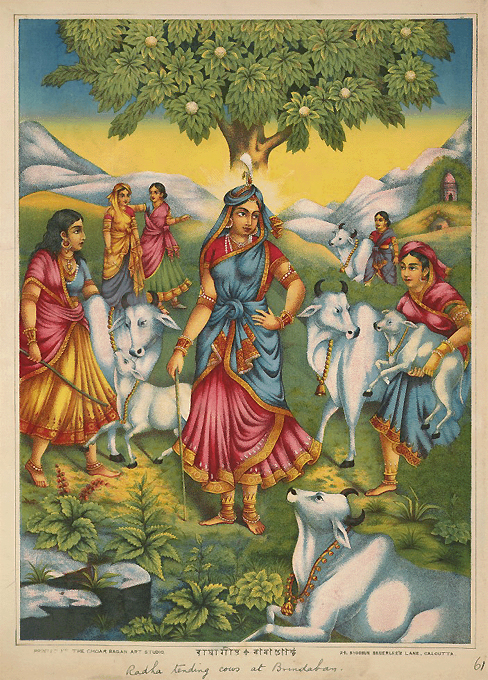
|
|
|
|
BY: SUN STAFF

Radha Tending Cows at Brindaban Mar 20, 2011 — CANADA (SUN) — A study of the historical, spiritual and cultural elements of Vedic design. In recent editions of this series we've covered a unique category of design motifs – the auspicious marks that are manifest on the hands and feet of transcendental personalities. Each mark represents a quality, circumstance or item of paraphernalia related to the divine individual who bears it. A number of these symbols are shared by various personalities, among them Sri Sri Radha-Krsna and Sri Sri Gaura-Nitai. The study of these auspicious marks gives us a rather granular view of Vedic design. The symbols are somewhat scientific, being descriptive of classifications of things, which makes the study of them quite different than, for example, narrative paintings. But starting today, it is the latter category we've moving into, as we begin a comparative study of Vaisnava images from Calcutta, circa late 1800's. Over the years, the Sun has featured many serial studies of Vedic artworks, from Bengali woodcuts and terracottas to illustrations from Bhagavat Purana and Gita-govinda. Our approach is usually to consider a collection of works, comparing one to another and looking at how the representations do or do not reflect the sastric narratives being illustrated. In this case, we will be presenting a collection of a few dozen beautiful and rare lithographs and oleographs produced by the Chore Bagan Art Studio in Calcutta, c. 1890-95. Relatively little information is available about the studio itself, aside from an academic study done by Christopher Pinney, Photos of the Gods. The Chore Bagan studio was located at 24 Bhoobun Banerjee's Lane in Calcutta, and played an important role in the dissemination of lithography in late-1800's Calcutta. Most of the content produced by Chore Bagan was spiritual, and more specifically, Vaisnava in nature. The artists who established the studio had previously attended the Government Art College, before joining together to produce the pioneering print works the studio became famous for. There are several aspects of the Chore Bagan prints that we find exceptional. First is the content, which as we said, is predominantly Vaisnava. But in addition to the typical images of Visnu, Shiva and Brahma, and scenes from the Mahabharata and Ramayana that so many India print studios produced in the 18th and 19th centuries, Chore Bagan focused primarily on Radha and Krsna, and on the Bengali Bhakti movement of Lord Caitanya Mahaprabhu. There was apparently a folio of works produced by the Chore Bagan which included more than 70 works, being paper prints mounted on cloth pages. These lithographs include many extremely bright, colorful and beautifully executed images of Krsna and Balarama, the Pancha Tattva, Lord Caitanya's sankirtana party, and numerous scenes of Sri Krsna's Vrindavan lila. While many of the scenes are traditional narratives of Krsna and Gaura-lila that will be familiar to the devotees, we hope our Sun readers will be as pleased as we were to have discovered such an extensive collection of beautifully rendered Vaisnava works that are rarely seen in circulation today. In fact, of the dozens of images, there are only a few in the collection that we have ever seen before -- and our archival collection is very extensive, comprising well over a million devotional images. As we hope to illustrate over the course of this survey, so many of the devotional paintings rendered by Chore Bagan are traditional, yet very unusual. The Chore Bagan artists copied well-established narrative scenes in the Vaisnava genre, as many artists who followed them did, and continue to do. But in making a comparative study of these prints, it will become obvious to the reader that the Chore Bagan artists produced highly unique renditions of these well known favorites, elevating them by their expert use of design, color and technique which, in most cases is most accurately described as chromolithographic. Following today's introduction, we leave the reader with a single example of the Chore Bagan style of printwork: an image of Radharani and the gopis tending the cows in Vrindavan. While every other print included in this series will be shown side-by-side with examples of similar renditions of the same scene, in the case of this print, we have no comparable to share. There are few images we have come across that depict Radha actively tending the cows with no gopas in sight, and none are arranged in this particular narrative scene. This singular example, a lithograph of Radha and the gopis tending cows certainly demonstrates all that we've suggested above about the excellence in color and design found in the prints produced by Chore Bagan. The colors are surprisingly brilliant, soft yet bright, with a lovely quality of light that transforms the scene. Sri Radha's transcendental form beneath the kadamba tree is most beautiful. Behind Her, the white hills are recognizable as Govardhan, but are also somewhat suggestive of the universally famous Himalayas. Two of Govardhan's shrines are there, and of course the adoring cows, one of whom is being carried like a pet by a gopi. The distinctive design of the kadamba tree is one that will appear in many of the Chore Bagan prints. That, and the style of clothing depicted in soft jewel tones, with traditional Bengali borders and ornaments, sets the stage for a wealth of Bengal Vaisnava images still to come.

| |